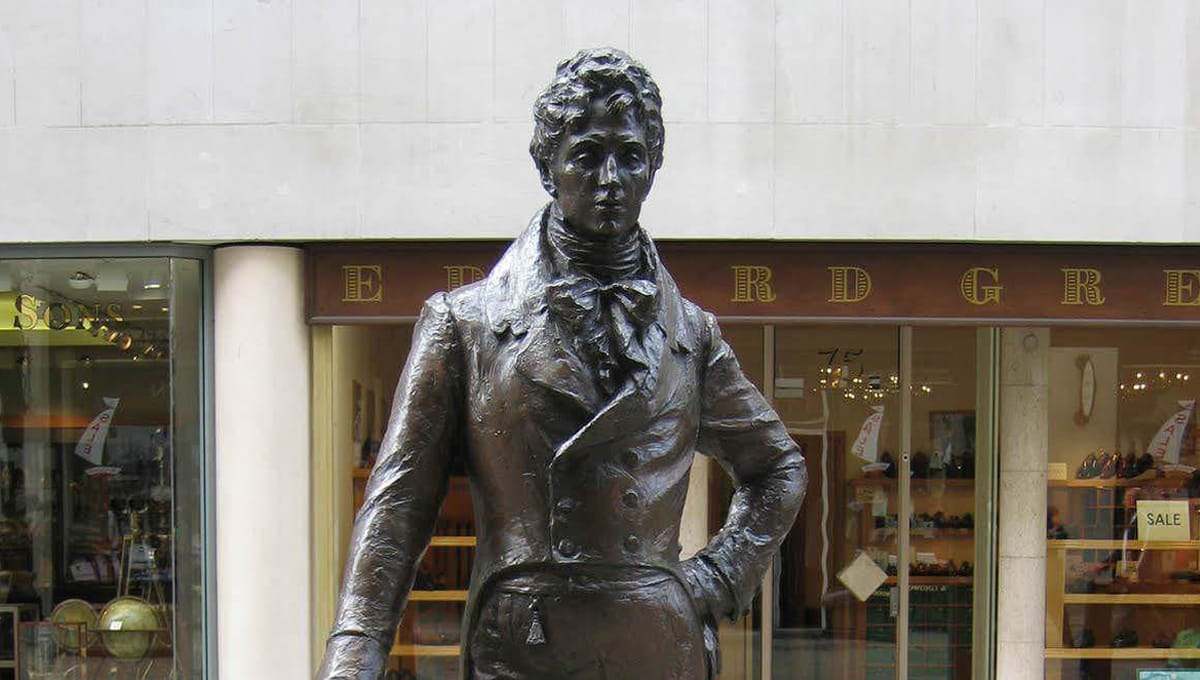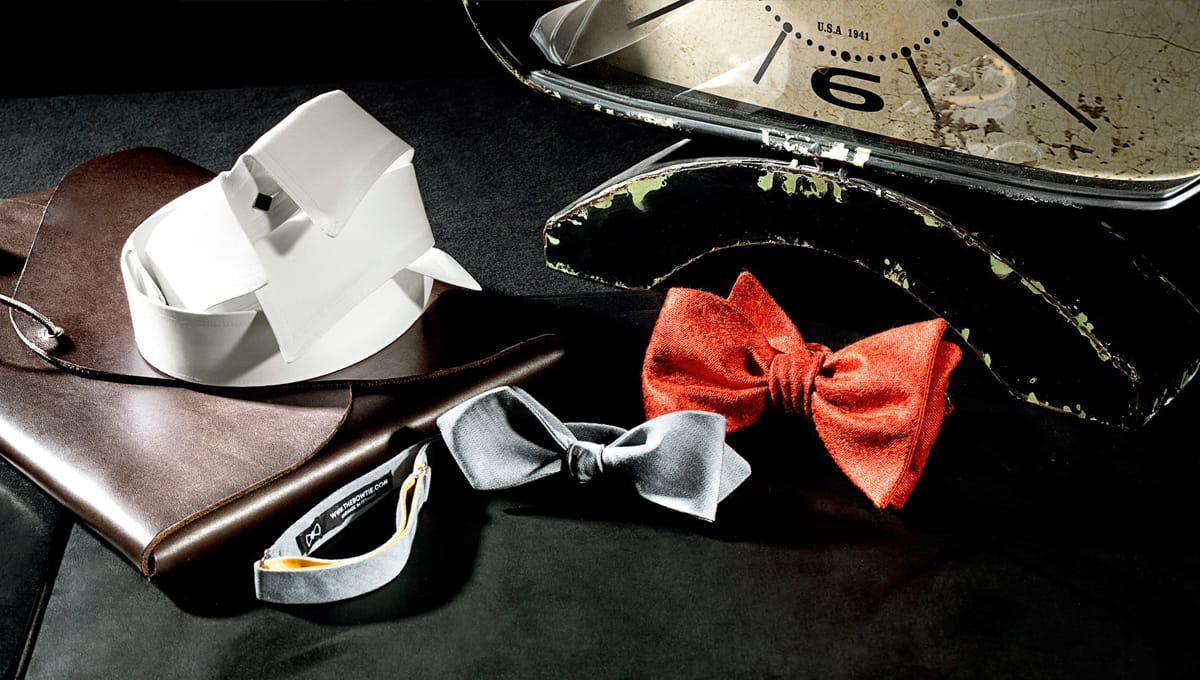
Beau Brummell
Though he may not have invented the aphorism “fake it ‘til you make it,” the life, deportment and rapid social climb (and eventually downfall) of George Bryan “Beau” Brummell, a man born in a servants’ attic, the grandson of a valet and son of a courtesan, is proof that a dedication to self image, eloquence, charisma and style can serve as the stepping stones towards a social climb of epic proportions.
As a lowly lieutenant in the Prince of Wale’s cavalry regiment, a middle-class man amongst noble-titled officers, Brummell’s unorthodox ways, witty charisma and larger-than-life personality quickly captivated the attention and admiration of the prince himself. This unlikely friendship afforded the commoner the ability to shirk his duties and do as he pleased, and catapulted him to captain status before other senior officers. Brummell resigned as captain, yet still maintained his place amongst the royal circle as the prince’s “favourite.” It was here, at the very center of the English royal circle that landed him a “personality cult” where his style, demeanor, lifestyle and very habitus were so revered that it was not only copied, but set the very regime for dressing that has held until this very day – a feat that has yet to be matched at even a fraction of the magnitude.
At the peak of his celebrity (a status of which he was the first to ever attain in the modern sense of the term), Brummell’s influence rivaled that of the most famous celebrities of our day in age, in a time when only those of royal status had ever had been afforded such authority. When still in his teens, Brummell was chosen to be the best man at the 1795 royal union of the Prince and Princess of Wales, and when only in his early twenties was described as the most famous and influential man in London. People copied what he wore, how he spoke, even how he shaved, clubs and dances were judged by his attendance and participation. Tobacconists sold out of his favorite tobacco, and tailors gave him goods simply for the honor (and publicity) of his wearing them. His sudden taste for beaver-skin top hats even set into motion the decimation of the beaver population of North America in the 19th century.
The beau (as he was simply called by his contemporaries) secured his place in history as the very first dandy, setting off a fashion revolution that dictates the way we dress and, in part, how we act today. Many French philosophers even claim that Brummell and his dandies “signaled a revolutionary age and the death of kings just as surely as the guillotine of the Declaration of Independence” (Kelly, 2007). The influences Brummell set into motion never faltered, as evidenced by his accreditation of the invention of the modern suit, collar, ties and trousers. However, by his late 30s Brummell had gambled away his fortune, publicly insulted his royal master, and was forced to flee to France to avoid debt incarceration, where he suffered from depression and self-delusion, ultimately ending up in an asylum (the social suicide of his day) where he died from syphilis an insane and lonely poor man.
The middle-class maverick’s incredible rise to fame and eventual fall from grace (so typical of modern day celebrities) is a journey of which today’s aspiring style mavens can learn much, even more than the inspirational style quotes and memes that bounce around Pinterest and show up in articles of various menswear magazines. Brummell’s rise to social stardom, securement of stature as the father of modern dressing, and eventual self-demise provides us with a rubric of how much can be achieved with simple styling and charisma and how much can be lost when an ego gets too large.
Dress for the life you want, not the life you have
Brummell had a “masquerade of superiority” that has a universal appeal because anyone can do it, despite their monetary worth or social status. He set forth the rubric for any man to act like a prince, an idea that marked the “dawn of modern concepts of self” (Kelly, 2007). Brummell proved that people can only see what you choose to show them, so if you show confidence and class, they will assume you are competent and capable to accomplish anything you set out to do.
Less is more
Brummell is famed for his quote, “If John Bull [everyman] turns around to look at you, you are not well dressed; but either to stiff, too tight, or too fashionable.” Brummell’s subdued style was focused on the details: perfection of fit, proportion and cut, quality of materials, and cleanliness. This expression of power and masculinity challenged the contemporary way of status dressing which had a focus on frivolity, flamboyancy and conspicuous consumption. Instead, Brummell instilled a subdued, tailored look out of his unique style that any man could incorporate, thereby dissipating the rigid sartorial delineations of status that had a hold over the way people adorned themselves. And for that, we thank him.
A great tailor is a man’s best friend
The widespread acceptance of Brummell’s tailored dressing is a testament to its superiority. There is something incredibly captivating about a man in an impeccably fitted set of threads.
Don’t mindlessly follow the crowd
His tailored look was extremely unorthodox for his time, but Brummell had the gusto to go against the grain, even without the money to back up his eccentricities. If not for his daring dart from the conventional, there would be no suit as we know it, for men or women. The craft of bespoke and tailoring on Savile Row would never have developed.
Cleanliness is next to godliness
As is well known, Brummel took hours to dress. In fact, the prince would often sit in Brummell’s bedchambers to watch in fascination as the beau’s “toilette” (the name for the dressing routine of the high class society) took place. Brummell bathed daily, paid close attention to keeping his teeth clean and face shaved, and he changed his shirt linens often. These cleaning habits were so out of the ordinary that it shocked his contemporaries, proof that if you feel something is right, you should go with your gut and ignore the naysayers.
Don’t live outside of your means
Brummel did not have the abundance of money like his social crowd. He was afforded his luxurious lifestyle from gifts and getting things for free because of the amount of publicity he would bring. The men he kept company with had a daily regime that including shopping in the morning and gambling late into the evening. These things he did not at first take part in, however, the novelty of living the high life eroded his self-discipline. He eventually ended up spending and gambling his small fortune as if it were as large as his peers, often squandering more money in a single night than most of his countrymen would earn in a lifetime. This led to his immense debt, forcing him to escape his home country to the refuge of France where we lived a lonely, sad life. Moral of the story: no level of entertainment is worth squandering away your life savings, pay attention to your finances and do not spend more than you can afford.
Never forget the “little” people
Brummell’s fame became so large that it exceeded that of his royal master, giving the self proclaimed snob enough of an ego boost that he forgot how he became established in the first place. At a masquerade ball that he and a few fellow dandies hosted, Brummell felt snubbed by the prince. He proceeded to unabashedly scoff the prince, referring to him as the “fat friend,” throwing Brummell from the prince’s royal circle and setting him off into a spiraling decline of self-deprecation that led to his ultimate demise. A prime example that no matter how famous you may become, never forget your roots and don’t burn bridges.

